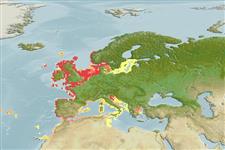Classification / Names
Common names from other countries
Main reference
Size / Weight / Age
Max length : 28.0 cm SL male/unsexed; (Ref. 4742); common length : 20.0 cm SL male/unsexed; (Ref. 4742); max. reported age: 9 years (Ref. 4742)
Length at first maturity
Lm ?, range 7 - 10 cm
Environment
Marine; reef-associated; non-migratory, usually 1 - 30 m (Ref. 35388)
Climate / Range
Temperate, preferred 12°C (Ref. 107945); 63°N - 28°N, 32°W - 25°E
Distribution
Short description
Dorsal
spines
(total): 14 - 17;
Dorsal
soft rays
(total): 8-10;
Anal
spines: 3;
Anal
soft rays: 8 - 11. A few cephalic pores (7-12) on snout. Lips with 5-7 folds. Scales on temporo-occipital surface 3-5 rows; on inter-operculum 2-3 (6-13) scales; on cheek 4-7; behind eye 1. A small dark spot on caudal peduncle. Often 5 large brown blotches near dorsal fin. Females and young: with numerous spots on body more or less longitudinally lined, some sinuous lines on head (Ref. 231). Coloration very variable; ground color of the male is greenish or blue while females are brownish to yellowish (Ref. 35388).
IUCN Red List Status (Ref. 115185)
Threat to humans
Harmless
Human uses
Fisheries: subsistence fisheries; gamefish: yes; aquarium: public aquariums
More information
ReferencesAquacultureAquaculture profileStrainsGeneticsAllele frequenciesHeritabilityDiseasesProcessingMass conversion
Tools
Special reports
Download XML
Internet sources
Estimates of some properties based on models
Phylogenetic diversity index
PD50 = 0.5005 many relatives (e.g. carps) 0.5 - 2.0 few relatives (e.g. lungfishes)
Trophic Level
3.4 ±0.1 se; Based on diet studies.
Resilience
Medium, minimum population doubling time 1.4 - 4.4 years (K=0.21-0.41; tm=2-3; tmax=9)
Vulnerability
Low to moderate vulnerability (34 of 100)
Price category
